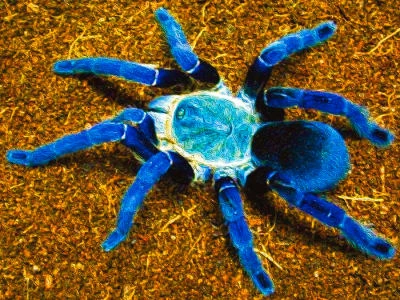1. Introduction to the Cobalt Blue Tarantula
The Cobalt Blue Tarantula, scientifically known as Haplopelma lividum, is a striking and sought-after species in the world of arachnid enthusiasts. Originating from Southeast Asia, specifically Myanmar, Thailand, and Malaysia, this stunning tarantula stands out for its vibrant cobalt blue coloration, making it a prized addition to many collections.
2. Physical Characteristics
This tarantula boasts an impressive appearance. Its body is covered in dense, velvety blue hairs, accentuating its robust build. The intense blue hue, especially visible in well-lit conditions, is one of the primary attractions for hobbyists. Additionally, it features striking black patterns on its legs, enhancing its allure.
3. Habitat and Natural Behavior
In the wild, the Cobalt Blue Tarantula inhabits tropical forests, favoring burrows and crevices as shelter. Its natural behavior includes a tendency to be reclusive and defensive, relying on its speed and venomous bite when threatened. Understanding its natural habitat aids in creating suitable living conditions in captivity.
4. Captivity and Care
When maintaining a Cobalt Blue Tarantula in captivity, recreating its natural habitat is crucial. A terrarium with ample space for burrowing, along with a substrate that retains moisture without becoming waterlogged, is essential. Maintaining appropriate humidity levels and providing hiding spots are key elements for their well-being.
5. Feeding and Diet
These tarantulas are predatory carnivores, feeding primarily on insects such as crickets, roaches, and mealworms. Offering live prey that’s appropriately sized ensures their nutritional needs are met. They are typically robust eaters and should be fed on a regular schedule, adjusting for molting periods.
6. Molting Process
Like all tarantulas, the Cobalt Blue goes through molting, shedding its exoskeleton to accommodate growth. During this vulnerable period, it’s crucial to provide a stress-free environment and avoid disturbing the tarantula. Ensuring access to water and refraining from handling is crucial during molting.
7. Reproduction and Lifecycle
Breeding Cobalt Blue Tarantulas in captivity requires specific conditions and careful monitoring. Mating rituals involve cautious introduction and observation of the male and female tarantulas. The female lays eggs in an egg sac, with the spiderlings emerging later. This process demands attention to temperature, humidity, and overall conditions for successful breeding.
8. Conclusion:
In conclusion, the Cobalt Blue Tarantula captivates enthusiasts with its stunning appearance and unique characteristics. Their care demands attention to detail, replicating their natural habitat for optimal health. While their venomous nature requires caution, their allure and beauty make them a prized addition to collections.
9. FAQs
Q1: Are Cobalt Blue Tarantulas suitable for beginners?
Cobalt Blue Tarantulas are not recommended for beginners due to their defensive nature and specific care requirements. It’s advisable to gain experience with other tarantula species before considering the care of this species.
Q2: How often do Cobalt Blue Tarantulas molt?
The frequency of molting varies, typically occurring every few months to a year, depending on factors such as age, diet, and environment. Younger tarantulas tend to molt more frequently than adults.
Q3: Are Cobalt Blue Tarantulas endangered?
While not classified as endangered, their natural habitats are threatened due to deforestation and habitat destruction. Conservation efforts to preserve their ecosystems are crucial for their long-term survival.
This comprehensive review aims to provide insights into the captivating world of the Cobalt Blue Tarantula, from its physical attributes to its care in captivity, shedding light on both its allure and the responsibility of keeping such a fascinating creature.
